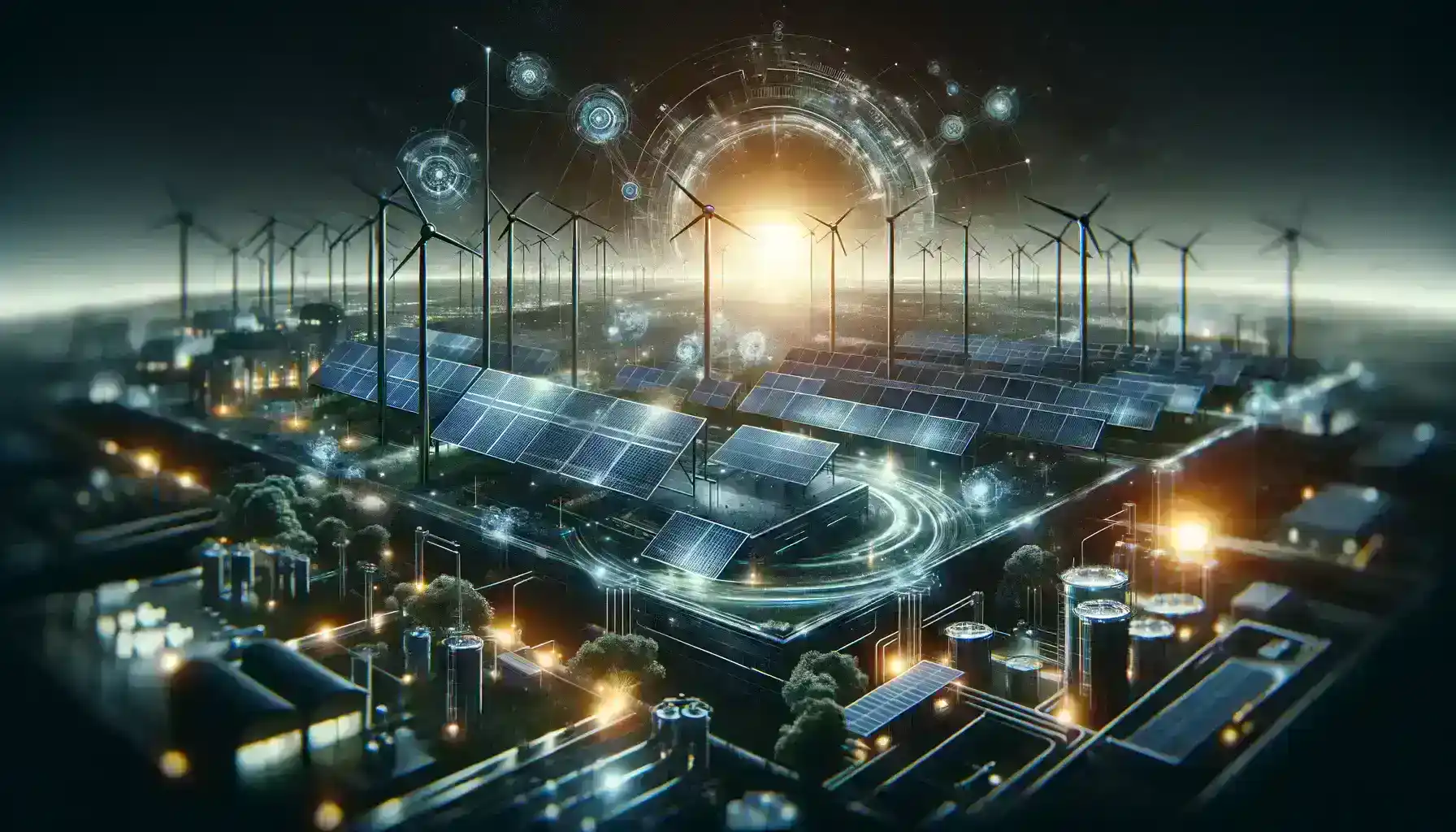Table of Contents
In the quest for a sustainable and resilient energy future, the solar power revolution stands as a beacon of innovation and progress. As the world grapples with the challenges of climate change and seeks cleaner alternatives, the integration of cutting-edge technologies is reshaping the energy landscape. At the heart of this transformation lies the pivotal concept of smart grid integration—a revolutionary approach that goes beyond conventional energy paradigms.
In this exploration of the solar power revolution, we unravel the intricacies of the technologies propelling this change, with a spotlight on the transformative role played by smart grid integration. Join us on a journey through the photons and electrons, where innovation meets necessity, paving the way for a future powered by sustainable, efficient, and intelligently managed solar energy.

The Rise of Solar Power
Historical Perspective
The historical journey of solar power is a narrative that spans centuries, marked by persistent innovation and a growing awareness of the need for sustainable energy sources. Initially, solar power existed as a niche technology, primarily harnessed for specific, isolated applications. Early experiments with solar energy date back to the 19th century, with scientists like Alexandre Edmond Becquerel making pioneering discoveries in photovoltaic effects.
However, it wasn’t until the latter half of the 20th century that solar power began to emerge from the shadows of niche applications. The oil crisis of the 1970s acted as a catalyst, prompting a renewed interest in alternative energy sources, with solar power taking center stage.
Throughout the 1980s and 1990s, advancements in solar cell technologies, driven by increased research and development efforts, started making solar power more accessible and economically viable. Governments and environmental organizations began promoting solar energy initiatives, offering incentives to encourage its adoption.
Solar Energy Today
Fast forward to the present, and solar energy has transcended its historical constraints, emerging as a mainstream and rapidly growing contributor to the global energy mix. The 21st century has witnessed a remarkable surge in solar power adoption, with an increasing number of countries incorporating solar technologies into their energy portfolios.
This section takes stock of the current state of solar energy, offering a comprehensive overview of the industry’s present landscape. Global adoption rates showcase the widespread acceptance and integration of solar power solutions, with numerous nations committing to ambitious renewable energy targets. Capacity trends highlight the exponential growth in solar power installations, emphasizing its expanding role in meeting the world’s energy needs.
Cutting-Edge Technologies
Advanced Photovoltaics
In the empire of solar power, the evolution of photovoltaic technologies has reached a transformative phase. Traditional solar cells, while effective, have given way to a new era marked by breakthroughs like perovskite solar cells and bifacial panels. Perovskite solar cells, with their unique composition, have demonstrated unprecedented levels of efficiency, promising a more cost-effective and scalable approach to solar energy generation.
Bifacial panels, designed to capture sunlight from both sides, further amplify energy yield, harnessing not only direct sunlight but also reflecting rays, making them a game-changer in the solar power landscape. These advancements in photovoltaics are not only enhancing the overall efficiency of solar cells but are also redefining the possibilities of harnessing energy from the sun.
Energy Storage Solutions
One of the inherent challenges of solar power lies in its intermittent nature—the sun doesn’t shine consistently. To address this limitation and ensure a continuous and reliable energy supply, energy storage solutions have emerged as a key players. Advanced batteries, such as lithium-ion batteries, are at the forefront of this revolution.
These batteries not only store excess energy generated during peak sunlight hours but also release it when the sun isn’t shining, effectively smoothing out the supply-demand curve. Additionally, molten salt systems, a form of thermal energy storage, are gaining prominence. These systems store and release heat energy, providing a reliable and flexible means of delivering solar power even during periods of low or no sunlight.
Smart Inverters and Grid Management
As solar power capacity grows, the need for intelligent and adaptive systems becomes paramount. Smart inverters play a pivotal role in this scenario. Unlike traditional inverters, smart inverters have the ability to communicate with the grid and adjust the flow of electricity in real time. This not only ensures a stable and consistent power output but also enables seamless integration with the grid. Moreover, sophisticated grid management systems are orchestrating the ballet of electrons on a large scale.
These systems use advanced algorithms to balance energy supply and demand, optimizing the overall efficiency of the grid. In the context of smart grid integration, these technologies are indispensable. They facilitate the two-way flow of electricity, allowing excess solar power to be fed back into the grid when available and drawing power from the grid when needed.
The Crucial Role of Smart Grid Integration

Smart grid integration represents more than just a technical evolution; it marks a paradigm shift in the fundamental way we conceive, manage and distribute energy. At its core, smart grid integration involves the seamless incorporation of advanced technologies and communication systems into the traditional power grid infrastructure. This amalgamation allows for real-time, bidirectional communication between energy producers, consumers, and grid operators.
Unlike traditional grids, smart grids leverage a network of sensors, meters, and intelligent devices to gather and analyze data. This data-driven approach empowers utilities with unprecedented insights into energy consumption patterns, grid performance, and potential faults. By harnessing the power of information, smart grid integration transforms the grid from a static infrastructure to a dynamic, adaptable system capable of optimizing energy distribution in response to demand fluctuations and external variables.
The importance of smart grid integration cannot be overstated. It lays the foundation for a more resilient, efficient, and sustainable energy grid, capable of meeting the evolving needs of our modern world. This transformation enables better resource management, minimizes energy wastage, and enhances the overall reliability of the energy supply.
Benefits
Improved Reliability: One of the primary advantages of smart grid integration is the enhanced reliability of the energy supply. By continuously monitoring the grid’s health, identifying potential issues in real time, and rerouting power to circumvent problems, smart grids significantly reduce the likelihood and duration of power outages.
Increased Renewable Energy Penetration: Smart grid integration technologies play a pivotal role in integrating renewable energy sources, such as solar and wind, into the mainstream energy grid. The ability to predict and manage the intermittent nature of renewables is crucial for ensuring a stable and consistent power supply.
Enhanced Energy Efficiency: Smart grids empower consumers with real-time information about their energy consumption, encouraging more conscious energy use. This leads to increased energy efficiency at both individual and collective levels, contributing to reduced overall energy demand.
Quick Response to Faults: Automated monitoring and control mechanisms enable swift identification and isolation of faults within the grid. This proactive approach minimizes downtime and accelerates the restoration of normal operations.
Challenges
Technological Complexity: Implementing smart grid technologies involves intricate systems integration and often requires the deployment of advanced hardware and software. This complexity can pose challenges during the initial stages of adoption.
Data Security Concerns: The increased reliance on data exchange within smart grids raises concerns about data security and privacy. Safeguarding sensitive information from potential cyber threats becomes paramount.
High Initial Costs: The upfront costs associated with upgrading infrastructure to accommodate smart grid technologies can be substantial. However, proponents argue that the long-term benefits in terms of efficiency and reliability outweigh these initial investments.
Regulatory and Standardization Issues: The absence of standardized regulations can impede the seamless integration of smart grid technologies across regions. A harmonized approach is necessary to ensure interoperability and consistent performance.
California’s Grid Resilience
In the face of increasing challenges posed by wildfires and extreme weather events, California has emerged as a trailblazer in integrating smart grid technologies to fortify grid resilience.
Environmental and Economic Impacts
Reduced Carbon Footprint
The adoption of solar power, bolstered by smart grid integration, constitutes a formidable weapon in the global fight against climate change. Traditional energy sources, such as fossil fuels, release substantial amounts of greenhouse gases into the atmosphere, contributing to the warming of the planet. In stark contrast, solar power generates electricity with minimal environmental impact. Photovoltaic systems convert sunlight into electricity without emitting harmful pollutants or greenhouse gases, positioning solar energy as a clean and sustainable alternative.
Smart grid integration enhances the environmental benefits of solar power by optimizing energy distribution and consumption. The intelligent management of the grid enables better synchronization of energy supply with demand, reducing wastage and optimizing the efficiency of renewable energy sources.
Germany’s Energiewende, or Energy Transition, serves as a compelling example of the successful integration of renewable energy into its grid through advanced smart grid solutions. Energiewende represents a comprehensive national strategy aimed at shifting from conventional, fossil fuel-based energy sources to a more sustainable mix dominated by renewables.
Economic Opportunities
Beyond its environmental advantages, the solar power industry, supported by smart grid integration, unfolds a spectrum of economic opportunities that extend far beyond the installation of solar panels.
Job Creation: The growth of the solar industry has a direct and positive impact on employment. From research and development to manufacturing, installation, and maintenance, the entire solar ecosystem fosters a diverse array of job opportunities. Skilled technicians, engineers, project managers, and even administrative roles are crucial components of a workforce that continues to expand with the increasing adoption of solar technologies.
Fostering Innovation: The solar power revolution is a hotbed of innovation. As the industry expands, there is a growing need for creative solutions to enhance efficiency, reduce costs, and address challenges. This innovation not only improves the performance of solar technologies but also stimulates research and development across related sectors. Smart grid integration, in particular, demands continuous innovation in software, hardware, and grid management systems, driving technological advancements that reverberate throughout the energy landscape.
Future Trends and Outlook
Emerging Technologies
As we peer into the future of solar power, a myriad of emerging technologies promises to elevate the industry to unprecedented heights. One such innovation is the continued evolution of photovoltaic materials. The emergence of tandem solar cells, perovskite-silicon hybrids, and other novel materials holds the potential to significantly boost the efficiency of solar panels, making harnessing sunlight even more economically viable.
Furthermore, the integration of artificial intelligence (AI) and machine learning into solar technologies is on the horizon. Smart solar forecasting, predictive maintenance, and optimization of energy production are areas where AI can enhance the overall efficiency of solar power systems. These intelligent systems can adapt to variable weather conditions and consumption patterns, ensuring a more reliable and responsive solar energy infrastructure.
South Korea’s Smart Grid City:
South Korea’s Smart Grid City initiative on Jeju Island stands as a compelling instance of innovative urban planning and sustainable energy development. Jeju, known for its natural beauty, became a testing ground for advanced smart grid technologies.

Policy and Regulatory Landscape
The future of solar power adoption and smart grid integration is intricately tied to the evolving policy and regulatory landscape. Governments worldwide are recognizing the pivotal role of these technologies in achieving sustainability goals and reducing carbon footprints.
One noteworthy trend is the formulation of policies that incentivize and streamline the smart grid integration solutions. Governments are increasingly recognizing the importance of flexible, adaptive energy grids in accommodating the growing share of renewable energy sources. Incentives for grid modernization projects and the development of regulatory frameworks that encourage investments in smart grid integration technologies.
Conclusion
In conclusion, the marriage of the solar power revolution and smart grid integration transcends a mere technological shift; it marks a profound reimagining of our energy ecosystem. The real-world samples highlighted throughout this exploration underscore the tangible impact of these innovations. From California’s enhanced grid resilience to Germany’s Energiewende and South Korea’s Smart Grid City in Jeju Island, the success stories speak volumes about the transformative potential of smart grid integration.
These instances serve as beacons illuminating the path to a sustainable future, where clean and efficient solar energy takes center stage. As we reflect on these achievements, it is evident that smart grid integration not only optimizes energy distribution but also catalyzes a paradigm shift towards a greener, more resilient energy landscape. The journey towards a solar-powered future is not just promising; it’s an imminent reality reshaping the way we power our world.





